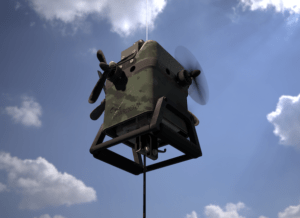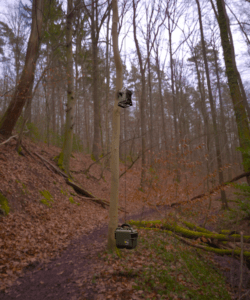
by DRONELIFE Staff Writer Ian M. Crosby
Leading international design, engineering, science, and risk management consultancy BMT has obtained a patent from the U.K. Intellectual Property Office for its ‘SPARROW’ autonomous air-ground payload transfer device, ideal for military drone delivery in addition to civilian applications.
“BMT’s patent signals a new type of suspended robotic device: a device that takes over responsibility for the final moments of payload delivery, and better suited to challenging and sensitive environments. This small, highly-ruggedised robotic device could even autonomously collect packages as well as deliver them without the need for infrastructure on the ground,” said Phil Metcalfe, Regional Business Director for UK and Europe. “With the development of this autonomous and highly-versatile concept the project team have delivered a great example of how BMT actively applies its innovation to solve its customers’ complex problems. Further, we were super excited to participate in the British Army’s “Army Warfighting Experiment” (AWE) 23, with our rugged technology demonstrating the potential to feed into the army’s plans for a future ‘digital backbone.”
SPARROW addresses the problem of loud, obstructive delivery drones needing to land or hover low over the payload destination. Different from winch systems employed in current trials for delivery drones, SPARROW lowers both itself and the payload at the bottom of a line, with the top attached to the drone above. This offers greater control over the payload and enables the larger delivery drone to remain out of the way at a higher altitude. Significantly smaller than the drone and without requiring lift-generating rotors, SPARROW is ideal for safe and quiet deliveries.

Initially developed for defense applications, SPARROW was selected early in its development by the UK Ministry of Defence for the highly competitive “Army Warfighting Experiment”. Its first demonstration was held in HM Naval Base Portsmouth, UK, in November 2022 with the associated ”Exploitation Event” in February 2023.
“As the system is developed further, it will provide a capability unlike anything else known to Defence,” cited the the AWE 23 independent Product Assessment Report. “It would enable the use of UAS to deliver payloads in the most challenging terrain, reducing risk to both the airframe, the payload and personnel on the ground.”
In addition to defense applications, this solution has potential value for manned helicopter operations and in sectors such as Maritime Ship-Shore deliveries, support to maintenance engineers on tall structures, Emergency Services, and e-commerce domestic deliveries. The project is seeking to partner for further Research and Development and license the technology to established operators.
Read more:
- Military Drone Support for Ukraine: Red Cat CEO Visits NATO Countries
- Canadian Military Tests DroneShield in Counter Drone Exercises
- These Companies Use Military and Aviation Radar to Scale Urban Drone Operations in Calgary
- 20 Drones, 1 Pilot: Matternets New Waiver Could Change the Economics of Drone Delivery
- Flytrex, Causey Aviation Unmanned Win Part 135 Air Carrier Certification for Long-Range, On-Demand Commercial Drone Delivery
Ian attended Dominican University of California, where he received a BA in English in 2019. With a lifelong passion for writing and storytelling and a keen interest in technology, he is now contributing to DroneLife as a staff writer.
Miriam McNabb is the Editor-in-Chief of DRONELIFE and CEO of JobForDrones, a professional drone services marketplace, and a fascinated observer of the emerging drone industry and the regulatory environment for drones. Miriam has penned over 3,000 articles focused on the commercial drone space and is an international speaker and recognized figure in the industry. Miriam has a degree from the University of Chicago and over 20 years of experience in high tech sales and marketing for new technologies.
For drone industry consulting or writing, Email Miriam.
TWITTER:@spaldingbarker
Subscribe to DroneLife here.
